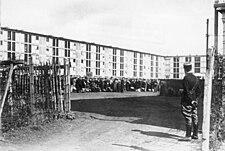
Back Camp d'internament de Drancy Catalan Sammellager Drancy German Στρατόπεδο του Ντρανσί Greek Koncentrejo Drancy Esperanto Campo de internamiento de Drancy Spanish اردوگاه درانسی Persian Camp de Drancy French מחנה הריכוז דראנסי HE Drancyi gyűjtőtábor Hungarian Campo di internamento di Drancy Italian
| Drancy | |
|---|---|
| Transit camp | |
 The accommodation block at Drancy with French policeman on guard | |
| Location | Drancy, France |
| Operated by | French police (until 1943) Nazi Germany |
| Commandant | Theodor Dannecker Alois Brunner |
| Original use | Utopian urban community |
| Operational | 20 August 1941 – 17 August 1944 |
| Inmates | French, Polish, Czechoslovak, and German Jews |
| Number of inmates | 67,400 deported; 1,542 remaining at liberation |
| Liberated by | French Resistance (indirectly Western Allies (Mainly the United Kingdom and United States)) |
| Notable inmates | Tristan Bernard, Eduard Bloch, René Blum, Max van Dam, Max Jacob, Charlotte Salomon, Simone Veil |
| Website | http://drancy.memorialdelashoah.org/en/ |
Drancy internment camp (French: Camp d'internement de Drancy) was an assembly and detention camp for confining Jews who were later deported to the extermination camps during the German occupation of France during World War II. Originally conceived and built as a modernist urban community under the name La Cité de la Muette, it was located in Drancy, a northeastern suburb of Paris, France.
Between 22 June 1942 and 31 July 1944, during its use as an internment camp, 67,400 French, Polish, and German Jews were deported from the camp in 64 rail operations,[1] which included 6,000 children. Only 1,542 prisoners remained alive at the camp when the German authorities in Drancy fled as Allied forces advanced and the Swedish Consul-General Raoul Nordling took control of the camp on 17 August 1944, before handing it over to the French Red Cross to care for the survivors.[2]
Drancy was under the control of the French police until 1943 when administration was taken over by the SS, which placed officer Alois Brunner in charge of the camp. In 2001, Brunner's case was brought before a French court by Nazi hunter Serge Klarsfeld, which sentenced Brunner in absentia to a life sentence for crimes against humanity.[3]
- ^ "This Month in Holocaust History – December – Drancy". Yad Vashem. Retrieved 20 April 2010. The 61,000 deported to Auschwitz and remaining number to Sobibor were murdered.
- ^ Cite error: The named reference
ushmmwas invoked but never defined (see the help page). - ^ "Alois Brunner". Jewish Virtual Library.
